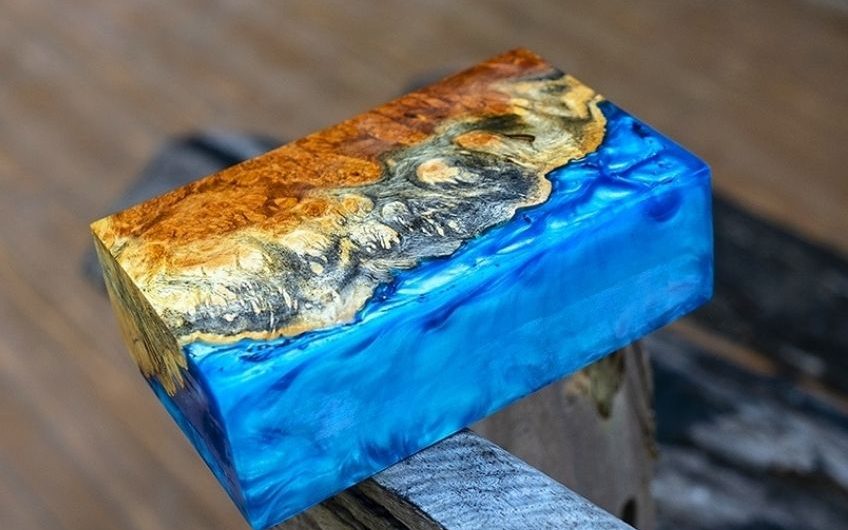Working with epoxy is mostly fun and creative, but you are bound to make a few mistakes from time to time, irrespective of whether you are an amateur or a pro. That is why in this article, we will help you understand some common mistakes with epoxy resin and how you can fix or repair them. It is also important to note that epoxy is best repaired or fixed when still wet. It becomes more challenging to repair the problem when the epoxy hardens. However, you can fix even the gravest epoxy mistakes by applying a second coat!
1. Tacky Or Sticky Epoxy
If you end up with a tacky or sticky epoxy, the chances are that water or moisture is trapped therein. You can fix this by removing the epoxy without covering it with an extra layer then applying a fresh resin layer. Giving the surface a moderate sanding before applying the second layer always does the trick.
2. Epoxy Won’t Bond
Your epoxy may not bond properly if you are using a contaminated surface. It helps to thoroughly clean your surface and apply a seal coat before you apply the epoxy mixture. The seal coat is a thin epoxy layer that seals all irregularities and prevents air bubbles from forming.
3. Epoxy Won’t Cure Long After Curing Time.
Most epoxies cure completely after 48 to 72 hours and will be dry to the touch after 24 hours. However, the curing time varies for various products, so it is best to check the resin kit. You can ensure that your epoxy cures within the required time by mixing the hardener and epoxy at the correct ratio first before adding any additives. We also recommend checking if the resin and hardener you picked are compatible because many aren’t.
4. Working In A Low-Temperature Area
Low temperatures can prolong the time it takes for your epoxy to cure or prevent curing entirely. We recommend adhering to the temperature ranges specified on your resin kit for optimum results.
5. Waves And Ripples On Epoxy Surface Finish
Bubbles, waves, and ripples are common imperfections, especially when you’re working with a wood surface. As such, you may have to apply two or more coats, starting with a thin seal coat to prevent air bubbles, followed by float coats of the same epoxy product.
6. Uneven Epoxy Finish
Most epoxy resins are self-levelling; you don’t need to do much to achieve an even finish. However, your epoxy resin may fail to level out as expected, especially if you use too little resin. All you need to do is up the resin amount to fix this problem; your work surface must also be level.
We always recommend mixing a bit more epoxy than you might need to ensure your surface is covered completely. If your epoxy has cured, you may have to sand the surface down before applying another coat so the next layer bonds properly. You can also pour another layer directly over your epoxy if it hasn’t fully cured after 12 hours to achieve a uniform finish.

7. Choosing The Wrong Product
Epoxy products are very diverse, making it challenging to choose one. There are epoxies for electronics, structural fillers, casting compounds, moulding, and bonding agents. Research on the best epoxy products for your project to avoid wasting time and money and end up with a mess or a finished product you cannot use.
8. Failure To Consider The Weather
Temperature is probably the most crucial aspect when it comes to working with epoxy. Most epoxies cure at certain temperatures, and this should guide you when choosing your working environment. Working out of the specified temperature range can cause your epoxy to cure too late, too soon, or fail to cure completely.
9. Improper Storage
Your epoxy should be stored at a temperature between 16°C and 21°C (60°F and 70°F) when not in use. Temperature fluctuations can cause your epoxy to solidify or crystallize, so you must ensure it is stored in a room with a somewhat stable temperature range.
10. Inadequate Surface Preparation
You must prepare your surface adequately before you apply your epoxy. The surface must be dry, free from oil, and clean to ensure your epoxy adheres to the surface and bonds as it should.
11. Failure To Mix The Epoxy Correctly
Most epoxies come in kits with two separate components that need mixing before you can get to work. This is where it gets a bit tricky. You must strictly adhere to the mixing ratio to avoid any blunders. Some mixing instructions ask that you mix by volume and others by weight, so you must have the appropriate measuring equipment. A mistake in the mixing stage may result in your epoxy hardening too fast, too slowly, or failing to harden entirely.
12. Glazed Coat Epoxy Problem
This phrase describes cloudy epoxy coats caused by air bubbles, humidity, or moisture reacting with your epoxy mixture before it cures. You can fix this by applying heat to your epoxy coating, removing any moisture and allowing for full curing.


















